The Montpellier metropolitan area is characterized by rapid urban development and significant population growth. This has led to a strong need for urban development, and a culture of car-based urban planning (common to many areas). However, the Montpellier metropolitan area has undergone a major political about-turn in its cycling policy. In 2020, Michaël Delafosse was elected mayor of Montpellier and president of the Metropole, with an ambitious program to reduce the use of private cars and develop the modal share of bicycles and alternative modes (public transport in particular).
To better understand this ambitious policy and to shed light on how Cycling Insights, our solution developed in partnership with Geovelo, can support it, we spoke to Thomas Lavaur, coordinator of the cycling mission, Arnaud Grenier, in charge of active modes studies, and Johan Peignin, in charge of employer mobility plans.
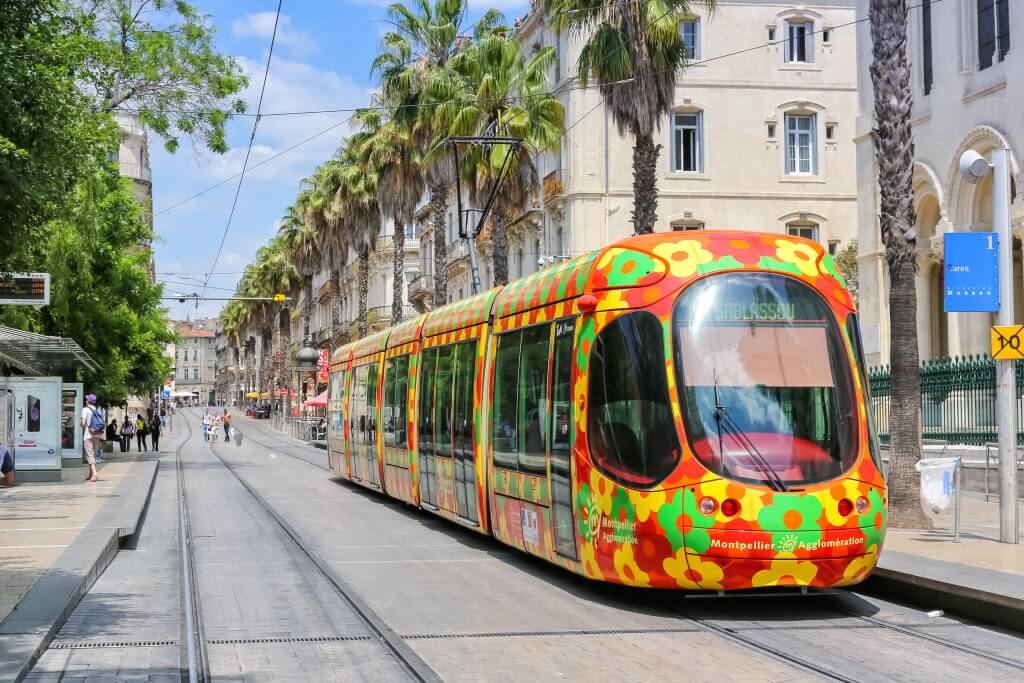
Montpellier, France – Tramway public transport transit transportation.
Transport policy
One of the emblematic measures of the new mandate is free public transport for all residents, which will be introduced on December 21, 2023. This is the largest network in Europe to introduce such free travel, and is a flagship action of the current mandate.
In addition to this flagship measure, the Metropole recently adopted its Mobilités 2025 Strategy, a vast plan that includes major investments in public transport and active mobility (in excess of 1 billion euros), including:
- the creation of a new tramway line
- a new high-level trolleybus service, to connect various districts of Montpellier, and serve the Metropole’s communes more efficiently
- a partnership with the company Klaxit to promote car-sharing (the Metropole already ranks 2nd nationally in terms of journeys made).
- a €150M program dedicated to active modes of transport, 2/3 of which is specifically dedicated to cycling, with the creation of a Bicycle Express Network.
- a purchase subsidy of €500 per inhabitant for electrically-assisted bicycles, regardless of income. Over 40,000 applications have been received to date;
- a policy to develop secure bicycle parking (velobox)
- work with the ecosystem of cycling associations: support for new uses, and joint work with associations on facilities and practices.
All these projects are designed to promote better intermodality throughout the region, with a range of services adapted to every situation.
Also worth noting: Montpellier is a tourist area, with major cycle tourism routes such as EuroVelo 8 nearby, as well as national and local routes (V70 and V830 to the east of Montpellier), all linked to Montpellier’s multimodal interchange hubs (Saint Roch and Sud de France). For the future, it is therefore planned to better integrate these itinerant or recreational uses for weekends and vacations into development projects.
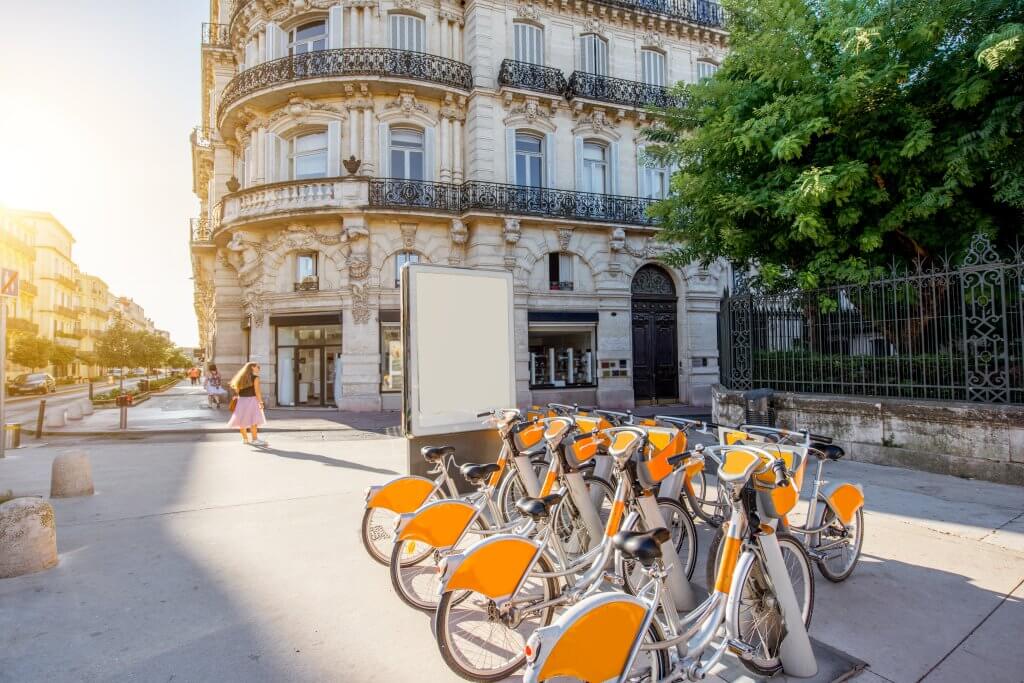
Montpellier, bicycles on the Foch boulevard
Details of the Bicycle Express Network
Voted for in May 2022, Montpellier’s Réseau Express Vélo includes 235km of identified bicycle facilities, with the aim of completing at least 50% by the end of the term.
This new Réseau Express Vélo (bicycle express network) consists of :
- A structuring plan comprising 15 “bike lines”: 11 radials, 4 bypasses + a central bike ring for cycling facilities in Montpellier’s historic and heritage center.
- This is complemented by a network of links and local routes to provide a finer, more complete network across the region.
Use of Cycling Insights to develop bicycle modal share
Usage data
To monitor the development of this ambitious program and increase the modal share of cycling in the Metropole, the Metropole of Montpellier uses a network of permanent counters (with data available in Open Data), as well as the Cycling Insights application, fed by data transmitted by Geovelo users (more information on Cycling Insights in our series of articles on the subject).
The data collected is used by the Metropole and partners to guide development choices: preference for one type of cycling facility or another at a given location, based on usage data. The data is also used during the initial stages of development projects. They can be used to confirm a feeling about types of travel or the number of people using the routes being redeveloped.
Cycling Insights’ ability to generate isochrones (a cartographic representation of the time it takes to cycle from point A to point B) is also consulted, albeit in an exploratory mode for the time being.
In addition to development projects, the data are communicated to elected representatives to inform them of the bicycle traffic on new developments. This was notably the case for the new cycle lane on Rue St Louis, which is showing very encouraging usage data (although continuity is not yet complete).
Cycling facilities and geographical data
The use of Cycling Insights has also made it possible to automate the work involved in surveying cycling facilities, which in the past had been carried out manually with a great deal of effort and time.
In addition to facilitating the census, the tool has enabled the creation of a shared database for all municipalities, and the reliability of the data, in conjunction with the Géovelo/OpenStreetMap community, which also contributes.
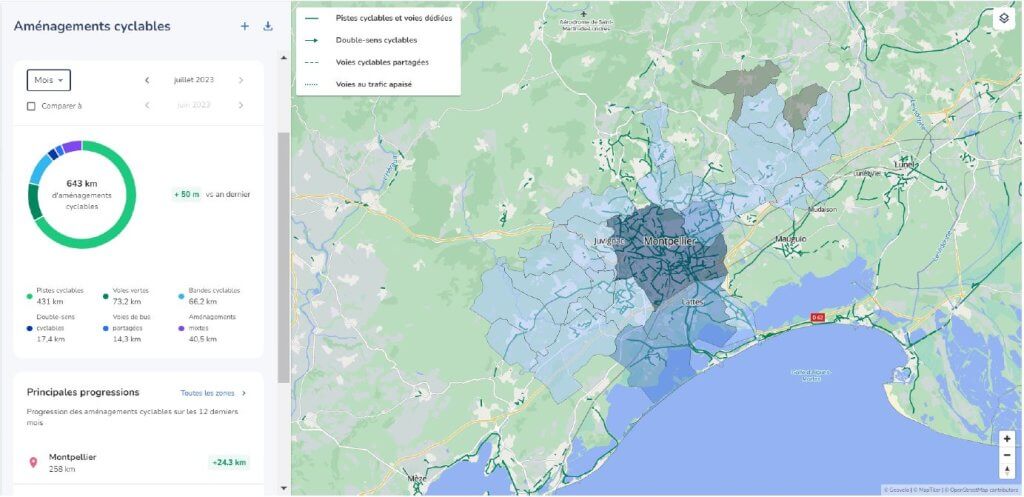
Example of an observatory of cycling facilities by type in the Metropolitan area, visible in Cycling Insights.
Partnership with the Geovelo user community
To date, Montpellier’s Geovelo community has 10,793 members, including 3,700 regular users.
Thomas Lavaur and Arnaud Grenier underline the importance of a tool that relies as much on the OpenStreetMap community as on the local authority, and of being able to benefit from the best of both, with users able to contribute, in the same way as the local authority, which ensures and optimizes the quality of map data, thanks to a dedicated control tool. The use of a citizen application (away from GAFA) makes perfect sense for establishing a real partnership with citizens!
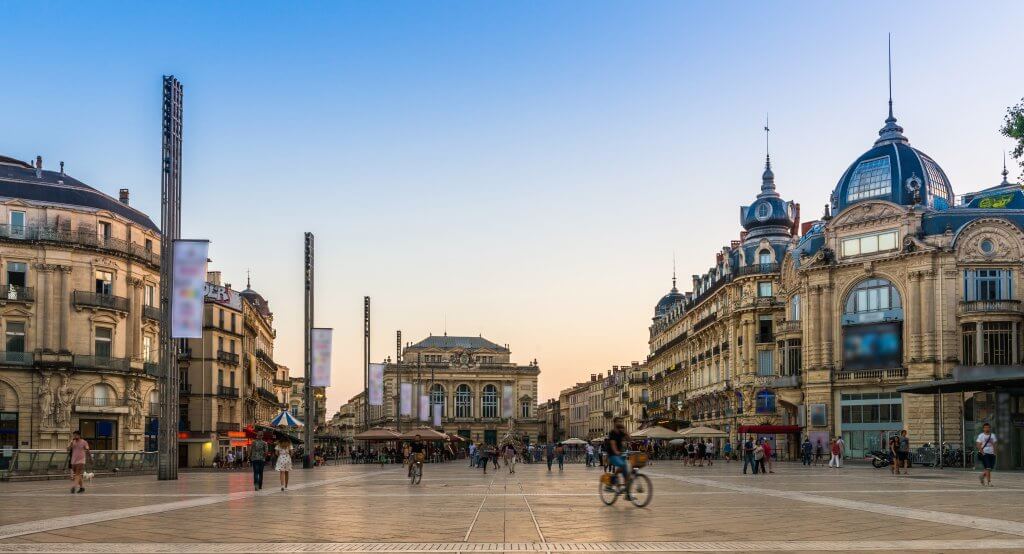
Achieved goals
Halfway through the term of office, the first results of this program to reduce the use of private cars and shift the balance in favor of active modes of transport and public transport seem to be bearing fruit.
Improved air quality
Air quality has improved in the Metropole: for the 3rd year running, the Metropole is below the State’s air pollution ceilings (it should be noted, however, that these years include the COVID period, which was marked by a sharp reduction in travel). Nevertheless, this improvement is very encouraging and authorizes the city to waive the obligation to set up a Low Emission Zone (LEZ) in Montpellier city center for the time being.
Growth in bicycle modal share
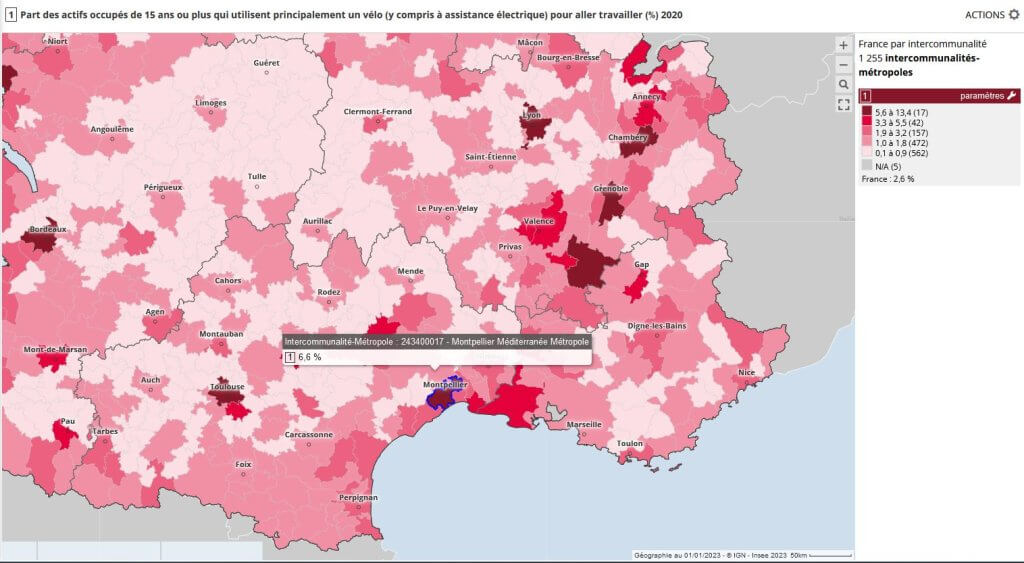
INSEE data on bicycle modal share in Montpellier and surrounding area
In 2014, the modal share of cycling was 4% in Montpellier city (2% for the intercommunality excluding the central city) and 3% for Montpellier Méditerranée Métropole, up slightly by +1% on 2004. The latest national survey[1] shows a modal share of 9.2% for the city of Montpellier, and 6.6% for the metropolitan area, representing a substantial increase and one of the highest averages among French metropolises. This progress is all the more encouraging given that the effort was even greater after 2020, a period not taken into account in this survey.
As a reminder, among large cities, Grenoble and Strasbourg are the ones where residents use active travel the most to get to work, particularly bicycles (17%). Between 2015 and 2020, the use of bicycles to get to work increased by 2 points in the central municipalities, reaching 6% at the start of 2020.
Users’ perceptions, via the Baromètre des Villes Cyclables of the Fédération des Usagers de la Bicyclette (Bicycle Users’ Federation)
Of the 3,461 contributions submitted for the 2021 Baromètre des Villes Cyclables, the City of Montpellier went from an average grade of F (unfavorable climate) in 2019 to D in 2021 (favorable climate on average), representing a +46% increase in positive feedback.
This is a notable performance compared with the national average, which shows a deterioration in the cycling climate (or an increase in user expections!): 2.98 in 2021 versus 2.9 in 2019 (the highest grades are the worst), i.e. -3%.
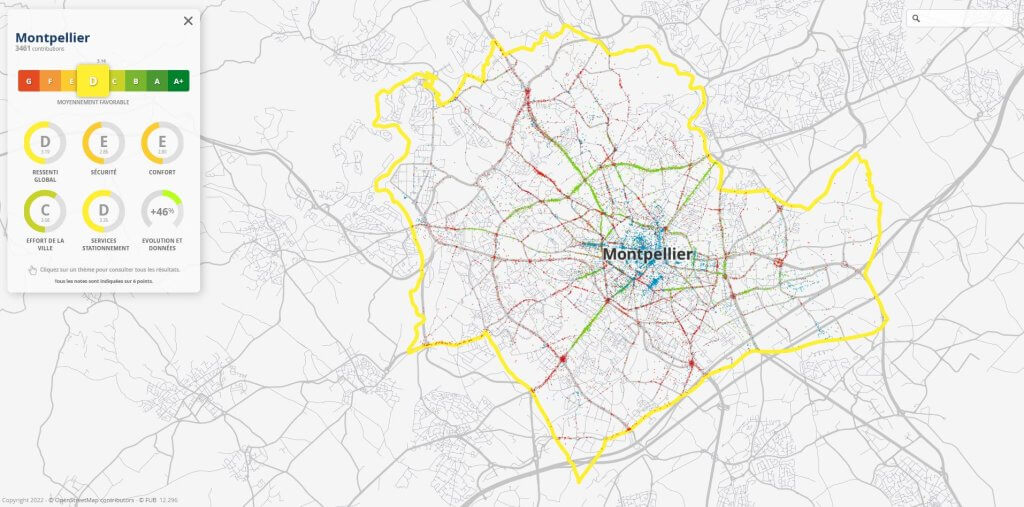
Evaluation of Montpellier in the Barometer of Bike-Friendly Cities 2021
Comparative trends in average bicycle and car traffic
Every year, the Mobility Department publishes a road traffic observatory that combines several data sources (including those provided by the permanent bike counters gradually being commissioned by the Metropole since 2019) to provide a comprehensive overview of changes in mobility.
Comparing a constant period between 2021 and 2020, the observatory notes an increase in bicycle traffic, which nevertheless varies from site to site. Rue de la Vieille Poste, for example, is up by 39%, and Quai des Tanneurs by 35%. The avenue de Lodève, the allée Beracasa and the Pérols lanes are up by between 15% and 19%, while the RM5 in Lavérune and the rue Gerhardt are up by around 10%. Only Avenue Delmas saw a slower rise in traffic, with an increase of 2%.
In comparison, car traffic rose by an average of 9% between 2020 and 2021, and some roads even saw a drop in traffic, particularly those that had been redeveloped. However, 2021 does not mark a return to the pre-pandemic situation. Between 2021 and 2019, traffic remains down by almost 9%.
For more details on the ridership figures for bicycle counting systems, the Vélocité Montpellier association has created a dedicated web page displaying the data, based on the Metropole’s Open Data platform.
Would you like to find out more about our bike traffic analysis tools? Contact us!
[1] Share of working people aged 15 or over who mainly use a bicycle (including electrically assisted) to go to work (2020 data, INSEE).






There is no comments